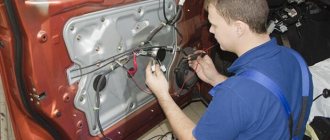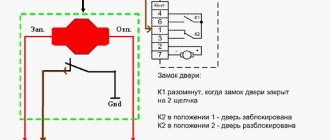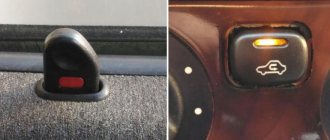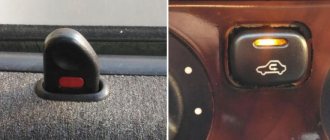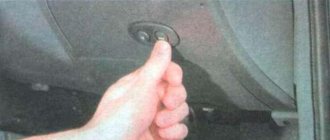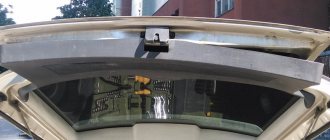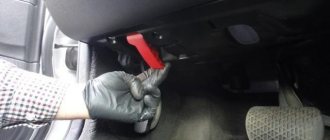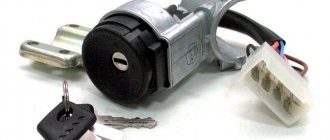Manufacturers, with each new car leaving the assembly line, increase its comfort and ergonomics. The cars are “stuffed” with electronic safety and comfort systems. They provide maximum driving pleasure.
The car central lock is a convenient and useful invention. Used over the past few decades. Its creation allowed the driver to get rid of unnecessary manipulations associated with opening and closing the driver's and passenger doors.
Since its inception, the central car lock has undergone a number of significant changes. Controls the opening of not only the doors, but also the trunk. The car's central locking cannot operate indefinitely. Sooner or later, malfunctions occur in its operation requiring repair or complete replacement of the system.
A person who gets used to good things is sensitive to the failure of comfort systems. He feels uncomfortable wasting time on manipulations that previously required just a finger press. A malfunction of the central locking forces the driver to look for information about why the central locking does not work .
At the end of the article you can find a video on how to repair a car's central locking system. It will be an excellent addition to the text material. Enjoy watching.
Functions and purpose of the central lock
The car's central locking is the “heart” of the security system. Responsible for monitoring the locks in the car. That is why it is called central. The signal sent from the key fob symbolizing the central control unit closes or opens the doors, windows, trunk and hatch.
Central locking is one of the car's auxiliary comfort systems. The development of the central locking system does not stand still. New car models are equipped with a system that ensures automatic closing of door locks when driving. Some car models combine central locking and alarm systems under a single control.
Central locking device
The central locking system is designed to ensure reliable operation under all conditions. It combines several basic elements, without which full use of the system is impossible. New cars have a complex central locking control scheme. Other components of the vehicle’s on-board system are involved.
The device of the central car lock:
1. Control unit.
The electronic control unit is used to transmit signals with commands to the mechanism switches and the central unit. The central unit, after decoding the command, opens or closes the doors, windows, trunk and hatch.
2.Input sensors.
Input sensors are also called microswitches. Work together with door lock limit switches. Microswitches determine and fix the position of the locks after a command from the central control unit.
3.Executive devices.
Actuators are represented by door and trunk locks. They open and close based on microswitch commands. The last link in the chain.
The central locking system operates independently of engine operation. The electronic control unit on the key fob is powered autonomously. A coin-cell battery is used.
Determining malfunctions of the central locking
Failure of the central locking system cannot occur spontaneously. There are harbingers indicating that the system is not working correctly or malfunctioning. They cannot be ignored. It is necessary to determine the cause of the malfunction as quickly as possible.
Reasons for failure of the car's central locking system:
1. Complete refusal.
Does not respond to pressing buttons on the key fob sending commands to the central control unit. Often the cause of the malfunction is trivial. A discharged key fob battery prevents sending a command to open or close locking devices.
2. Partial refusal.
It is characterized by alternating periods of normal operation in normal mode and a complete refusal to respond to remote control commands.
3. Malfunction of locks.
The malfunction manifests itself as chaotic operation of the locks. They can randomly close, open or be completely blocked without responding to incoming commands. The malfunction is dangerous because the doors can be completely blocked without the possibility of mechanical opening. You have to remove the door trim and open it manually.
Before you begin repairing the central locking system, you must determine the cause of the malfunction.
The procedure for localizing failures and disturbances in the system:
1. Alarm testing.
If the central locking is combined with an alarm system, it is necessary to inspect it first. The door locking devices do not respond to signals from the control panel; they must be checked mechanically using the ignition key.
If the central locking operates in manual mode, you need to check the electrical and control circuits of the alarm. One of the common options is that the battery in the key fob may have run out.
2. The central locking does not work completely or partially.
When testing the central locking system, it refuses to work or operates irregularly in manual mechanical mode using the ignition key. It is necessary to clarify the nature of the manifestation of the malfunction.
If there is a complete system failure on the vacuum central locking system, the compressor operation cannot be heard. The electric central locking responds with weak, barely audible clicks of the operating relay. The locking device buttons remain stationary.
It is necessary to locate the central locking circuit fuse. If it is burnt out, replacing it will solve the problem of mechanism failure. Depending on the car model, there may be more than one fuse.
3. The system fuses are intact and undamaged.
If it is determined that the fuses are safe and sound, you must continue to persistently examine the system to determine the cause of the malfunction.
The cause of malfunctions in the operation of locking devices may be the lack of voltage supply to the input elements of the driver's door actuators. The malfunction occurs after wire breaks or terminal oxidation and breaks contact.
The driver's door drive cannot transmit the signal received by it from the control panel to the other doors. Similar symptoms appear when the driver's door actuator limit switch is faulty. The control signal is not detected.
Repair work on the central system must begin with checking the power supply and control signal. It is necessary to visually check the system wires for damage. The limit switch must be checked. It is installed inside the drive.
4. Arbitrary opening or closing of door locks.
Often, after pressing the key fob button, the door locks close and after a few seconds randomly open. The opposite sign of a malfunction also appears when the locks close without giving a signal.
The cause of the malfunction is a violation of the fixation of the rod fasteners. Located between the drive and the driver's door lock mechanism. There is a violation of the process of unlocking and locking doors.
Causes of malfunctions
If the central locking stops working, you must first check the fuse box. Short circuits and various disturbances often occur in the central locking system, which leads to blown fuses.
The central lock does not operate when the battery is completely discharged. To check, you need to open the central locking with the key and try to start the car. If it does not start, then the reason is the battery is discharged.
The reason why the central locking system does not work may be due to a breakdown of the electronics. You can open the car without a key using the key fob. If the central locking does not open with the key fob, you should check the batteries and buttons of the key fob. They may stick and not work at the right time.
At the next stage, using the instructions, you should check the alarm control unit. It is possible that due to problems with it, the central locking works, but does not close all the doors. The last thing to check is the microboard, which is located on the activator motor, and at the same time the drive itself should be checked. Defective parts must be replaced.
Electrical circuit diagram for central locking
If the central locking does not work, this may be due to mechanical problems: the cylinder drive hose is faulty. The signal received by the control unit from the key fob is transmitted to the motor on the doors, which should operate and act on the hose fixed in the cylinder. If one end of the hose falls out of the cylinder, the drive is turned off. In this case, the door will not be able to open or close. Thus, the reasons why the lock does not work or malfunctions can be either electrical or mechanical.
Repair of vacuum central locking
Common malfunctions of vacuum central locking:
1.Opening and closing of door locks continues until the pump stops working.
The cause of the malfunction is condensation formed during temperature changes. The driver's door actuator switch contact malfunctions. The switch is dismantled and the condensate is removed. It may need to be replaced.
2. Uneven operation of car door locks.
On some doors, the locks close late or continue to remain open after receiving a command from the control panel. The compressor continues to operate until it is switched off by the protection system.
The vacuum line tubes are checked for leaks. The door line where the fault was found is inspected. Damage can be detected by hearing by the characteristic hiss of escaping air. Damaged tubes require replacement.
The pump control board does not receive a signal to close the door locks. He continues to circulate air. Damage to the electrical wire occurs in the door corrugation.
The signals reach the pump board, but it continues to work ignoring them. To repair the fault, the compressor unit is disassembled. The oxidized terminals of the alarm pneumatic sensor are being cleaned. If these steps do not help, then the pump control board has failed.
Failure options and their causes
On the new Peugeot 508, 301, 207, 308, 408, 607, 306, Partner, Boxer and other popular models of this brand, the auto manufacturer installs electric central locks, which are a system of solenoids that drive the lock mechanism, which is controlled by a central board. The problem may lie in a breakdown of the electric drive itself, the control board, or the communication channels between them (connection wires). Main failure scenarios:
- The lock stops opening from the remote control, although it opens properly using the key through the driver's or passenger's door. In this case, the breakdown is most likely in the alarm or electronics. Peugeot is characterized by a loss of communication between the key and the central locking system. To restore it, you need to perform the communication procedure again; it is individual for each model. For example, on a Peugeot Partner you need to insert the key, turn on the ignition and immediately hold down the lock button for 10 seconds, then turn off the ignition.
- The device begins to jam and open “with varying degrees of success.” Drivers often allow this breakdown to occur until it becomes unbearably difficult to open and close the door. The problem may be due to failure of the solenoids, which is especially common in the cold season. Poor contact may also be to blame. Also, the central locking system will work in a similar way if the gears or moving parts of the activator have worn out.
- The central locking engines continue to operate after the doors are opened (which is clear from the characteristic buzzing of the drives in the car). Such a breakdown indicates that the device cannot “understand” that the door is already open, and continues to work until the overheating protection turns on. In this case, the problem may be on the board or in the connection (damage and disruption of communications).
- Complete failure (the lock does not respond to either the remote control or the key, none of the doors open). In this case, you need to pay attention to the operation of the drive: if the doors do not open, but you can hear the lock motor operating, this may indicate failure of the activators (due to wear, bad weather or damage). If there is no sound at all and the system shows no signs of life, it can be assumed that the drives, control board or power system have failed.
